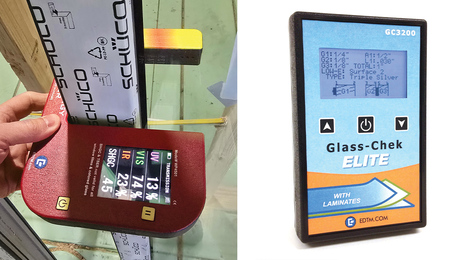what is typically used to make a pattern, say 4 ft long of where a formed formica top will go (say between two walls)??
cardboard?
plywood?
paper?
Discussion Forum
Discussion Forum
Up Next
Video Shorts
Featured Story

New devices showcased at the Builders' Show make it easy to measure glass performance, u-factor, SHGC, window thickness, and more.
Featured Video
SawStop's Portable Tablesaw is Bigger and Better Than BeforeHighlights
"I have learned so much thanks to the searchable articles on the FHB website. I can confidently say that I expect to be a life-long subscriber." - M.K.
Fine Homebuilding Magazine
- Home Group
- Antique Trader
- Arts & Crafts Homes
- Bank Note Reporter
- Cabin Life
- Cuisine at Home
- Fine Gardening
- Fine Woodworking
- Green Building Advisor
- Garden Gate
- Horticulture
- Keep Craft Alive
- Log Home Living
- Military Trader/Vehicles
- Numismatic News
- Numismaster
- Old Cars Weekly
- Old House Journal
- Period Homes
- Popular Woodworking
- Script
- ShopNotes
- Sports Collectors Digest
- Threads
- Timber Home Living
- Traditional Building
- Woodsmith
- World Coin News
- Writer's Digest


















Replies
The local countertop fab shop I use has a supply of 5' x 8' sheets of cardboard that they (or others) can use to make templates. The solid surface guy will use door skin material and build up a template with hot glue. Some will use tick sticks glued to a central piece to deliniate the corners and significant jogs. Depending on the edge treatment, some will take the longest wall to wall measurement and then scribe to fit as they go or just cover up the rough edge with splash. I know a guy who has put in a bunch of countertops and never templates - he covers with backsplashes and uses a LOT of almost matching color caulk. What a joke.
just scribe to fit, inside three walls is little tricky but doable
The shop local to me uses 1/8" luan. and what they'd do for something like this, with an inside to inside measurement, is use two pieces each 3' wide. One's for the left half, one's for the right, glue them in the middle once they fit the side and back walls and you have your complete template.
Edited 6/19/2003 9:06:23 PM ET by Cloud Hidden
Personally I think the very best material for templating is a panel material called "Sintra" (3mm (1/8") & 6mm (1/4”)) that's used for display and exhibit work. We do some of that kind of work so we often have some of it lying around but it not something you can just run out to the lumber yard or homestore and get. If there is a sign materials supplier near you you might try them as a possible source or you might try Scott Signs. There no website for the place in NJ where we order it and I don't have their name or phone number handy here at home, sorry.
Other than that we use are 1/8 masonite or luan or we'll pick up some kind of cheap thin paneling from a local Home Depot to use. 1/8 and 1/4 foam core too. I generally leave it up to the tradesperson doing the templating to select what kind of material they want to use since some are better than others for different types of scribing and fitting conditions.
View Image
"Never doubt that a small group of thoughtful, committed citizens can change the world. Indeed, it's the only thing that ever has." - Margaret Mead
Edited 6/19/2003 9:41:49 PM ET by Jerrald Hayes
plam supply may have "reclaimed" laminate. Full sheets of plam of colors no longer stocked--often with color sanded off and sold as backer stock.
Are you making the top? Just use the top material and scribe to fit. Pull it out and apply laminate.
all those you mention will do. For a 4' size you mention, you could probably just slam a straight edge against the back wall,butt a rafter square into the corner(s), and see how it looks, measure ant gap.
Slickest templating technigue I saw was transparent PVC sheet. The guy I saw doing it first stretched masking tape over the sink base and dish washer hole, so the material wouldn't sag there(thin stuff, only a couple mils), then cut to fit a 25" wide sheet of the stuff,placed it on the base cabinets. Marked sink cutouts and other pertinet info right on the sheet.
Best part, when the guy was done, he rolled it up and stuffed it in a tube, like they were construction drawings or something, and went on to the next job. No flimsy luan screwed-together patterns that will get squashed in the back of the truck on the way back to the shop.